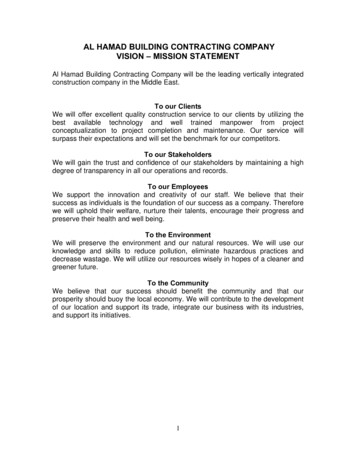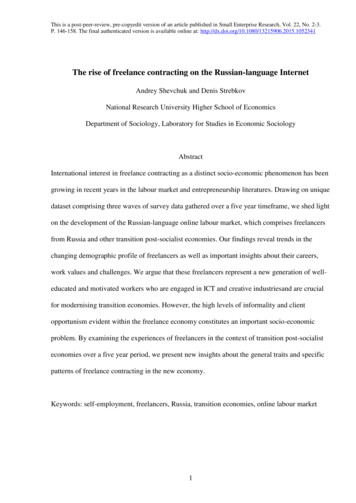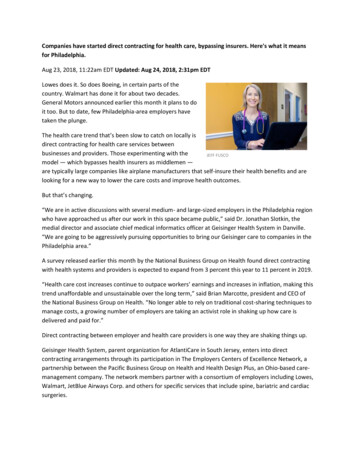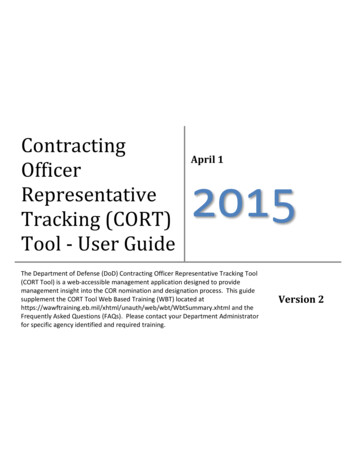
Transcription
VALUE-BASED CONTRACTINGIN HEALTHCARE: WHAT IS IT ANDHOW CAN IT BEACHIEVED?Jeff McCombs, PhDRebecca Myerson, PhDYifan Xu, MSRobert Popovian, PharmD, MS
AUTHOR AFFILIATIONSJeffrey McCombs is an associate professor of pharmaceutical and health economicsin the USC School of Pharmacy.Rebecca Myerson is an assistant professor of pharmaceutical and health economicsin the USC School of Pharmacy.Yifan Xu is a 5th year doctoral student in the USC School of Pharmacy'shealth economics program and a research assistant at the USC School of Pharmacy.Robert Popovian is the vice president of U.S. government relations with Pfizer Inc.April 2019Support for this work was provided by the Schaeffer Center for Health Policy & Economicsand by Pfizer through a research fellowship to the USC School of Pharmacy. The viewsexpressed herein are those of the authors, and do not necessarily represent the viewsof the funders. McCombs is a doctoral advisor on funded fellowships from AbbVie, theKomoto Family Foundation, and Bristol-Myers Squibb, and he has served on advisoryboards of several life sciences companies. Myerson has received funding from Bristol-MyersSquibb for investigator-initiated research. Xu was awarded a Pfizer Fellowship for doctoralprogram support. Popovian is an employee of Pfizer Inc and owns stock in the company.This paper has undergone the Schaeffer Center white paper quality assurance process, ledby Emmett Keeler, Schaeffer Center Senior Fellow and Quality Assurance Director.In addition to his review, the paper was reviewed by two scholarsnot affiliated with the Schaeffer Center.
ABSTRACTDynamics that guide the branded consumer market—market price, availableincome and expected benefits – break down in healthcare where the inherentcharacteristics of healthcare goods and services prevent patients from comparingmarginal value against price. Specifically, information asymmetry and healthinsurance cause healthcare markets to not function like other consumer markets.Given this, we asked the question of how the delivery and financing of healthcarecan be reorganized such that healthcare utilization decisions would mimic thedecisions of a sufficiently knowledgeable consumer paying the full price of care.Presently, efforts to link payment and value are hampered by the fragmentation ofthe U.S. healthcare system. We argue that value-based contracts must incentivizethe clinical decision maker, usually the physician, to allocate treatment basedon both price and value. In such an allocation, the patients with high expectedbenefit from treatment would be treated even at a high price and the number oftreated patients increases as price drops, mimicking a demand curve in the marketfor consumer goods. Our review of the existing healthcare system suggests thatchanging certain elements in the financing system could create an environment forsuccessful value-based contracting without having to reform the entire system.INTRODUCTIONThe total cost of healthcare in theUnited States reached 3.3 trillionin 2016, or 10,348 per capita.1Healthcare consumed 17.2 percentof the U.S. gross domestic product,exceeding all other developedcountries. For example, Switzerlanddevotes 12.3 percent of its GDPto healthcare while Canada haslimited healthcare spending to10.4 percent of GDP.1 The returnon our investment of resourcesinto healthcare is lagging whenmeasured using common publichealth metrics. For example, theU.S. has the lowest life expectancyand highest infant mortality rateacross all 13 OECD countries forwhich data are reported.2 It is nosurprise that questions concerningvalue are rife in the U.S.The purpose of this paper isto discuss the concept of ‘valuebased contracting’ which is beingpursued primarily by developers ofnew, patented medical technologies(e.g., drugs, medical devices) andlarge buyers of their products,such as health maintenanceorganizations (HMOs), healthinsurancecompanies,andgovernment programs. Healthinsurance companies are also usingselective contracting with hospitalsand physician groups with thegoal of reducing price, controllingutilization and improving qualityof care.3–7 Small governmentprograms, such as the Veterans’Administration and the Departmentof Defense, negotiate aggressivelyon price for pharmaceuticals andother healthcare products,8 whileMedicare is restricted from pursuingsimilar contracting approaches.9We begin by reviewing howconsumer markets for brandedproducts set prices, allocate productsacross consumers and, ultimately,establish the share of GDP allocatedacross most sectors of our economy.Next, we briefly review the natureof healthcare as a consumer productand detail the reasons why healthcaremarkets do not function like otherconsumer markets. The questionis whether value-based contractscan be constructed to correct theseflaws in markets for healthcare.Finally, we review past attemptsto control prices and utilizationsthrough the lens of value-basedcontracting, including those withphysician-facing and patient-facingincentives. These comparisons leadus to argue that the potential impactof value-based contracting on costand health outcomes may dependstrongly on the payment context towhich they are added.1
PRICE AND ALLOCATION OFRESOURCES IN MARKETSFOR BRANDED CONSUMERPRODUCTSIndividual consumers and headsof households purchase brandedconsumer products based on marketprice, available income and expectedbenefits (utility). The consumerpurchases a mix of products suchthat the expected benefit per dollarspent is equal across all productsconsumed. That is, individualconsumers ration their own use ofconsumer goods based on expectedbenefits, prices and income.These dynamics break down inhealthcare markets. The inherentcharacteristics of healthcare goodsand services prevent patients fromcomparing marginal value againstprice:1. Consumers [patients] do notvalue healthcare intrinsically,but rather value healthcare asan input in producing health.Health is valued both as aconsumption good, adding toutility, and as an investment inhuman capital.10 Moreover, the‘investment’ value of preventiveservices and prescriptiondrugs, for example, reduce therisk of future medical events,sometimes decades into thefuture.2. Determining the optimalcombination of healthcaregoods and services to producehealth requires specializedtraining. Patients dependon healthcare professionalsto serve as their agent forhealthcare decisions.113. Due to the uncertainty offuture demand for healthcareand the risk of high futureexpenses, patients demandhealth insurance. Forhistorical reasons related totax subsidies for employerprovided insurance, insuranceis relatively generous and is notbased on value in the U.S.12,134. Demand for healthcare isinflated by insurance. A patientpaying a fraction of the priceof healthcare services willis willing to consume morehealthcare than they would ifthey were paying full price.14–165. Health insurance providerscompete for enrollees based onup-front costs of joining theplan (premiums), generosityof coverage provided, and thequality of care provided andhealth outcomes achievedamong enrollees. Consumersare much more responsiveto premiums than otherplan features, and are oftenill-equipped to assess thegenerosity of coverage orquality of care provided, evenwhen this information isconveyed to them.17–21These unique characteristics ofhealthcare have resulted in the overconsumption of healthcare in manycases. In such a context: Can value-based contracts beconstructed that ensure thathealthcare is purchased andconsumed by patients onlywhen its expected benefitsexceed its cost? Can value-based contractsmimic the self-rationingby consumers that drivesallocation of income acrossalternative products themarkets for normal consumergoods and services?We consider these questions below.TREATMENT PROTOCOLSAND EVIDENCE-BASEDMEDICINEIn the medical literature, theterm ‘cost-effectiveness’ is used toLeonard D. Schaeffer Center for Health Policy & Economics2summarize the health benefits agiven health service provides to apatient, relative to its price.The need to explicitly modelcost and effect distinguisheshealthcare from other goods andservices. For most non-healthcaregoods and services, the consumer/head of household evaluates themarginal benefits of an array ofconsumer products and pays fullprice. An increase in price willcause consumers to reduce theiruse of a product, and producers/sellers recognize this inversedemand relationship between priceand quantity when they set price.In contrast, in healthcare marketswith insurance, patients may overconsume healthcare because theyare not personally liable for payingthe full price.To reduce over-consumption ofhealthcare that is not cost-effective,health systems use a myriad of toolsaimed at controlling utilization.Sellers of health care technology alsoface a myriad of payment systemsand pricing regulations aimed atcontrolling price. A value-basedcontract between sellers and buyersof healthcare can then be defined asan agreement on price coupled withan enforceable method of allocatingthe use of healthcare based on costeffectiveness.The key element of any valuebased contract is the treatmentprotocol. Health benefits varyacross patients, just as the marginalutility of consumer products varieswidely across consumers, andthe treatment protocol allocatestreatments to patients based onthis health benefit. A treatmentprotocol can serve as the equivalentto the market ‘demand curve’ forthe population covered by thebuyer. Once a contract price isnegotiated, the buyer of the healthservices (i.e., typically an insuranceprovider or government payer)would incentivize patients and theirphysician agents to allocate careto those for whom it is most costeffective, while staying within the
buyer’s budget (i.e., the sum ofall funds collected from patientsand available to be spent on care).Ideally, the expected benefits perdollar spent across covered patientsand all healthcare goods and servicesshould be equal across coveredpatients. This maps to buyers settinga price per unit of health produced.Unfortunately, developing andimplementing treatment protocolsat this level of detail would requiremore coordination across payersand providers than is typical inthe U.S. healthcare system, as wellas a larger evidence base than iscurrently available. Every healthcaregood and service would require anevidence-based treatment protocoldocumenting the relationshipbetween its expected impact onpatient outcomes and the patient’scharacteristics. Finally, onceprotocols are in place, the buyerwould need to incentivize patientsand their physicians to allocatetreatment according to the protocol.Below, we consider the gapbetween current practice and theoptimal treatment protocols, andhow this gap can be closed. Howwell do the methods for connectingpayment and value currentlyemployed in the United Statesencourage use of cost-effectivetreatment, and where would theimpact of optimal treatmentprotocols be largest?THEORY VERSUS PRACTICE:HEALTHCARE COSTCONTAINMENT EFFORTS INTHE UNITED STATESIn a classic theoretical paper,Kenneth Arrow claimed that anoptimal level of healthcare canbe produced if physicians takeon risk and are paid based onpatient outcomes.14 Yet despite thesignificant attention paid to Arrow’sseminal article,22 and similar findingsin subsequent theoretical papers,23–25risk-sharing arrangements of thisnature remain relatively limitedin the U.S.26–28 Data limitationsand interoperability are cited asa key barrier preventing adoptionof performance-based risk-sharingarrangements by health insurers[buyers] and other large payers.29In practice, the cost containmentefforts most commonly used canbe described as full capitation,partial capitation, bundling, pay forperformance, changing patient costsharing, and utilization restrictions,each of which we will define anddescribe below. These effortscan be critiqued by consideringhow they address the followingkey components of value-basedcontracting: treatment protocoldevelopment, price negotiation,and creating incentives for patientand physicians to follow protocolguidelines.Full CapitationIn a fully capitated healthcaresystem, a provider or groupof providers accept the fullresponsibility for providing healthto its members in exchange for aset fee per month or year. In theUnited States, this is often achievedby using a Health MaintenanceOrganization (HMO), a healthinsurer that directly controls allpatient care and only fully coverscare provided by its closed networkof providers.In a competitive insurancemarket, a value-based contractmay emerge between enrollees andtheir HMO if patients are providedwith information about qualityof care achieved and fees chargedby each HMO.30 Fully capitatedHMOs perform two functions fortheir enrollees which lead to thisresult. First, the HMO determinesthe quality of care provided tothe patient. That is, the HMOrecommends and provides a specificregimen of recommended healthcaregoods and services to the patient,which results in a certain amount ofhealth improvement. HMOs withfully integrated delivery systemshave the managerial systems inplace to implement ration servicesHOW WELL DO THEMETHODS FOR CONNECTINGPAYMENT AND VALUECURRENTLY EMPLOYED IN THEU.S. ENCOURAGE USE OFCOST-EFFECTIVE TREATMENT?WHERE WOULD THE IMPACTOF OPTIMAL TREATMENTPROTOCOLS BE LARGEST?3
bases on marginal health benefit, ifthey so choose. Second, the HMOmust adhere to a budget determinedby the total fees collected. In ascenario where patients can selecttheir HMO and are informed ofthe quality of care achieved and feescharged by each HMO, HMOswill compete on both price andquality. That is, the HMO willhave to be incentivized to selectpatients’ treatment regimens tomaximize quality of care within agiven budget, by rationing healthservices based on their incrementalhealth benefits.In the U.S., plan selection occursonce a year during an open enrollmentperiod, at which time consumersare provided with information onhealth plan premiums, servicescovered, breadth of the physicianand hospital networks, patientsatisfaction and the level of healthprovided to its members. In suchan environment, HMOs will losebusiness in competitive healthinsurance markets if they are notefficient producers of health, thatis, provide enough value to theirpatients relative to the fees theycharge. The result is a value-basedcontract between insurers andpatients; if value standards are notupheld to the patient’s satisfaction,they simply switch plans.31,32Partial CapitationAs an alternative to full capitation,partial capitation is also used in theU.S. context. In this payment model,providers take on some but notall financial risk for the healthcaregoods and services provided to thepatients they care for on an annualbasis.In Medicare, the governmentinsurance program for the elderlyand disabled, a new payment modelusing partial capitation is calledAccountable Care Organizations(ACOs). ACOs are groups ofhealthcare providers who aregiven incentive payments and facefinancial risk based on the costs andquality of care achieved for Medicarepatients who receive the pluralityof their care from these providers,measured annually. Recent studieshave found that the impact of theACO model on costs, quality ofcare, and patient outcomes has beenrelatively small.33–35The ACO model has also beencriticized for holding physiciansat-risk for the outcomes [e.g.,expenditures, hospitalizations]achieved by patients whose care is notfully under the physician’s control.36ACO leaders have complained thatthe financial incentives paymentsthey receive are insufficient toreimburse providers for the up-frontinvestments necessary to improvepopulation health.37 Finally, thereis a disconnect between the annualACO payments and individualclinical decisions by patients andphysician which are limited to apartial bundle of services. Giventhis disconnect, it is not surprisingthat this partial capitation modelhas not produced large changes inclinical practice to align cost andvalue.38BundlingA third payment approachfrequently used in the UnitedStates is called bundling. Ratherthan being paid for the numberof months that the patient is intheir care (e.g., HMOs), bundlinginvolves paying healthcare providersfor each discrete bundle of care,such as a hospital episode.A classic example of bundledpayment in the U.S. is Medicare’sprospective payment system (PPS)for hospital services. The PPS paysan administered price per hospitalvisit which is set administrativelyand adjusted for the patient’scurrent healthcare needs, definedusing clusters of diagnoses calleddiagnosis-related groups [DRG].After the PPS was implemented,hospitals were no longer reimbursedbased on the cost of care or on anitemized hospital bill. As a result,the PPS/DRG payment systemresulted in an immediate andLeonard D. Schaeffer Center for Health Policy & Economics4significant drop in length ofstay for Medicare patients.39–41Bundling of hospital services intoDRGs has also affected the mixof pharmaceuticals used in thehospital. Indeed, the advent ofpharmaceutical economics followedthe advent of the Medicare’s PPS/DRG payment system whichincentivized hospital pharmacymanagers to evaluate the price andeffectiveness of the medicationspurchased.Medicare is implementingadditional bundled paymentinitiatives. For example, Medicarehas proposed bundling the cost ofoncology drugs into its paymentsto oncologist, thus placing thephysician at financial risk for themix of medications used.42 Earlyevaluations of voluntary BundledPayments for Care Improvement(BPCI) initiative indicate thatproviders(hospitals)whichparticipated received reducedpayments without reductions inquality.43There are three main impedimentsthat must be addressed before abundling system will result in avalue-based contract. First, thebundle of services must be the mostefficient mix of services needed toproduce the health outcome desired.However, Medicare is prohibitedfrom using cost-effectiveness indetermining bundles for payment orsetting the administered price paidfor each bundle of services. Theseconstraints may impede Medicarebundling systems from achievingthe cost-effective use of services.44In particular, if the price set perbundle does not accurately reflectits value, it would be unsurprisingfor inefficiencies in care to remainpervasive under an administeredpricing system. Second, becausethe price per bundle or episodeof care is fixed, the provider hasan incentive to economize on costwithin an episode, but not on thenumber of episodes. For example,the PPS system creates a financialincentive to shorten length of
hospital stays and increase the riskof readmissions. To counteract thisincentive, the Medicare programinitiated penalties for excessreadmissions within 30 days. ThePPS system also created incentivesfor hospitals to discharge patientsearly to nursing home facilities.Finally, bundled service systemsalso encourage provides to selectlower cost patients and avoid moreseverely ill patients. In a competitivemarket, where providers willbe incentivized to provide highquality care to retain their marketshare, these impediments may besomewhat reduced.Pay-for-PerformanceAn alternative to payinghealthcare providers based on theamount of time they are caring for apatient, or the type of care provided,is paying based on outcomes. Thisis the concept underlying pay-forperformance (P4P) or payment-forquality schemes.In P4P schemes, achievinga clinical ‘success’ may triggeradditional payments, and/or clinicalfailures may trigger financialpenalties. The crucial issues insetting up P4P payment systems,therefore, are how to define successand failure and set the price/penalty for success/failure. Thesedefinitions and payments mustbe structured carefully to avoidunintended consequences.45,46 Forexample, payments defining successas a change in an intermediatelaboratory value (e.g., patients’ LDLcholesterol levels) may be moreclosely correlated with
health economics program and a research assistant at the USC School of Pharmacy. Robert Popovian is the vice president of U.S. government relations with Pfizer Inc. April 2019 Support for this work was provided by the Schaeffer Center for Health Policy & Economics and by Pfizer through a research fellowship











